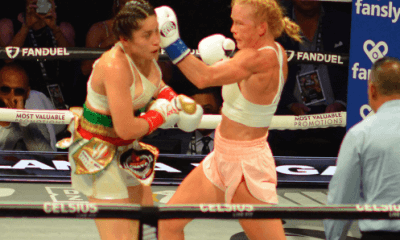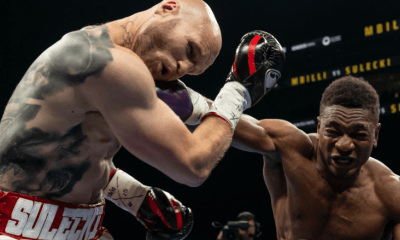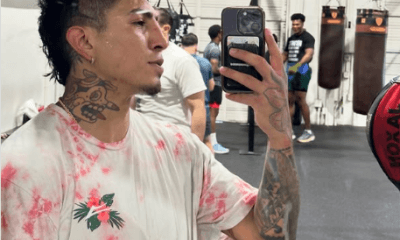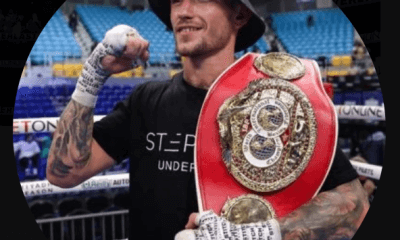Featured Articles
Shakur Stevenson’s Star Turn Gets No Media Coverage in Atlanta
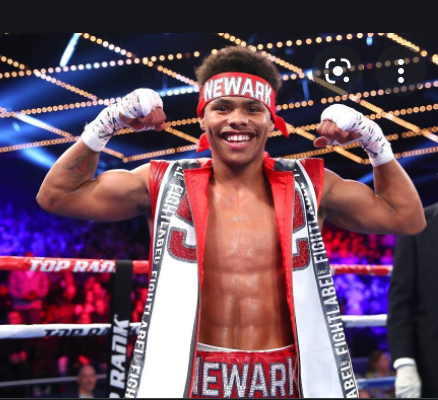
Shakur Stevenson’s Star Turn Gets No Media Coverage in Atlanta
For that part of the sports world that takes notice of boxing, Shakur Stevenson announced himself as a superstar-in-the-making – well, maybe – in totally dominating and ultimately dethroning WBO junior lightweight champion Jamel Herring Saturday night in Atlanta’s State Farm Arena. Shakur, the 24-year-old southpaw and 2016 Olympic silver medalist from Newark, N.J., seemingly hit Herring, 35, a combat-toughened but outgunned Marine Corps veteran, with everything but the proverbial kitchen sink en route to a 10th-round stoppage that wowed, among others, former junior welterweight and welterweight titlist and ESPN commentator Timothy Bradley Jr., who had chided Stevenson, a sometimes risk-adverse defensive wizard, as a “boring” fighter in his most recent bout on the Worldwide Leader, a 12-round scorecard shutout of Namibia’s Jeremia Nakathila on June 12 in Las Vegas.
After referee Mark Nelson stepped in to save the bleeding and battered Herring 1 minute, 30 seconds into round 10, Stevenson surprised Bradley by thanking him for providing the motivation he needed to ramp up his offensive output.
“Shakur tonight showed a ton of maturity,” Bradley said of the new-look, presumably more fan-friendly version of Stevenson that was on display. “The fact that he thanked me and said that I motivated him is a beautiful thing. That showed even more maturity, because that’s all that I want from these young fighters. I want them to grow.
“This is what I wanted to see from Shakur Stevenson. But I knew he had it in him, and he showed it tonight.”
Not that Bradley has completely bought into the notion of all that Stevenson could be, citing the lack of the only weapon – one-punch power – in his otherwise well-stuffed trick bag. Maybe that will come should Stevenson (17-0, 9 KOs) continue to enhance his man-strength, and maybe what you see now is all that fight fans can ever expect to get. In baseball terminology, Shakur Stevenson was more or less categorized by Bradley as a high-average singles hitter with enough gap power to accumulate a fair share of doubles that can get opponents out of there on accumulated damage. Who could complain if Stevenson, whose avowed goal is to become a superstar and fixture at or near the top of everyone’s pound-for-pound lists, continues to show flashes of such stylistic predecessors as Pernell Whitaker and Floyd Mayweather Jr.?
On this night and in the fight’s host city, however, Stevenson took a worse media-coverage battering from Eddie Rosario than he had administered to Herring (23-3, 11 KOs) with his fists. Rosario, a trade-deadline acquisition of the Atlanta Braves, slugged a three-run homer to lift his new team to a 4-2 victory over the Los Angeles Dodgers in Game 6 of the National League Championship Series at nearby Truist Park, sending the Braves into their first World Series since 1999. For now, Rosario, who went 14-for-25 with three homers in winning the NLCS Most Valuable Player Award, is the toast of the town and the focus of reams of space in The Atlanta Journal-Constitution sports section. But it wasn’t only Rosario who siphoned attention in the local paper away from Stevenson; the fight might have gotten a few lines in the print editions, but online it was completely ignored by the AJC, Rosario’s hot bat followed in the pecking order by stories about the NBA’s Hawks losing at Cleveland, the Georgia Tech Yellow Jackets dropping a high-scoring contest at Virginia and a five-star high school defensive end prospect named Mykel Williams verbally committing to the No. 1-ranked Georgia Bulldogs.
While it had to be frustrating to Stevenson and Atlanta’s fight fans for the event to be ignored by AJC, there were other deserving participants on the card who were similarly overlooked by the press in Georgia’s largest city. Not that anyone in the Internet age still pastes newspaper clippings into scrapbooks, but 19-year-old middleweight prospect Xander Zayas might be at a similar embryonic stage of development once occupied by Stevenson a couple of years ago. He deserved at least some recognition in the paper for his fourth-round stoppage of Dan Karpency, as did two other undercard fighters with celebrity familial ties: middleweight Nico Ali Walsh, grandson of the great Muhammad Ali, who scored a third-round TKO of James Westley II, and junior middleweight Evan Holyfield, son of four-time heavyweight champion and Atlanta-area resident Evander Holyfield – can it be nearly 30 years since “The Real Deal” shook off an early knockdown to stop Bert Cooper in seven rounds on Nov. 23, 1991, in Atlanta’s since-demolished Omni Coliseum? — who bombed out Charles Stanfield in two rounds.
But Atlanta is not the only metropolis that devotes fewer newspaper column inches, if any, to the sport that once made Evander Holyfield as important a local sports figure as any Falcon, Brave or Hawk. It will be up to Stevenson to break through, if he can, to a level where his every ring appearance becomes a must-see because boxing’s viability is and has always been largely tied to the popularity of its larger-than-life figures.
“I wanted a fun fight – show my skills, my boxing, my power,” Stevenson said of the modifications he and trainer/grandfather Wali Moses made from the relative dreariness of the wide points nod over Nakathila to the pulse-quickening pummeling of Herring, who apologized to the Marine Corps in general for his defeat, not that any such admission was necessary. Herring seemed to be contemplating retirement, but there has never been any occasion when he failed to conduct himself honorably inside the ropes.
The question now is, will Stevenson continue to hew to demonstrate the aggressiveness he exhibited against Herring? His comments following the Nakathila bout suggest that it might not always be so. His style is evolving, but what works better on one night might not be advisable on another.
“To be honest, I didn’t really like my performance,” Stevenson said after his paint-by-numbers dismissal of Nakathila. “I felt I could’ve performed a lot better. I was being real careful because he has power. He was real scary. I got the best defense in boxing. But I’ll be better in my next fight.”
Former super middleweight and light heavyweight champion Andre Ward, a 2021 inductee into the International Boxing Hall of Fame who also did commentary for Herring-Stevenson, said Shakur shouldn’t feel pressured to become something he is not in order to meet anyone else’s expectations.
“I think we got to kill some of these misnomers that have been around the sport for far too long, that fighters that go about their craft a certain kind of way, hit and don’t get hit, {means} there’s something not tough about them,” Ward said. “I heard that my whole career. Floyd Mayweather heard that his whole career. Just because a skillful fighter who can think and plays chess when everybody else is playing checkers doesn’t mean he can’t get down and dirty. It only means we’re going to get down and dirty when we have to.
“Fighters who have (high) IQs and skill, keep doing what you’re doing. Some people are going to like it and others won’t. It’s a marathon, not a sprint. If a good fighter has a bad night, he can still win every round. If a guy who takes two to {land} one had a bad night, it’s a pretty ugly night. He’s probably going to get knocked out or take a lot of punishment.
“I wasn’t who they wanted me to be. I just beat all those guys, all the guys they said were going to get me. I just kept winning. And winning covers a lot of problems and issues.”
A lot, for sure, not all. In addition to Whitaker, Mayweather and maybe Ward, there are elements of Stevenson’s makeup that call to mind the technical proficiency of two-time Cuban gold medalist Guillermo Rigondeaux, a former Top Rank fighter. Stevenson has been groomed by Top Rank for a prolonged and successful run at the elite level, but what so far has been a mutually beneficial working relationship could hinge in part to the fighter’s willingness to more regularly perform as he did against Herring than he did against Nakathila and a few other opponents that led to the perception that he was supremely talented, yes, but also a touch boring.
Prior to Rigondeaux’s release by Top Rank, company founder Bob Arum complained that his style leaned more to Masterpiece Theater than Rocky, which made Rigo a poor box-office and television attraction. Arum even said that when he brought the Cuban’s name up to HBO executives, “they throw up.”
There are many ways to win a prizefight, and now Shakur Stevenson has shown that he can win with chamber music or semi-heavy metal playing in the background. How far he advances in his march toward the truly elite status he is convinced is his destiny may be determined by the method he chooses to employ should a much-discussed showdown with Mexican blaster Oscar Valdez (30-0, 23 KOs) take place in 2022. The hard truth is that a lot of fight fans not only like, but require splashes of blood-and-guts mixed in with their favorite sport’s artistic side.
Editor’s Note: Bernard Fernandez, named to the International Boxing Hall of Fame in the Observer category with the class of 2020, was the recipient of numerous awards for writing excellence during his 28-year career as a sportswriter for the Philadelphia Daily News. Fernandez’s first book, “Championship Rounds,” a compendium of previously published material, was released in May of last year. The sequel, “Championship Rounds, Vol. 2,” with a foreword by Jim Lampley, arrives this fall. The book can be ordered through Amazon.com, in hard or soft cover, and other book-selling websites and outlets.
Check out more boxing news on video at the Boxing Channel
To comment on this story in the Fight Forum CLICK HERE
-
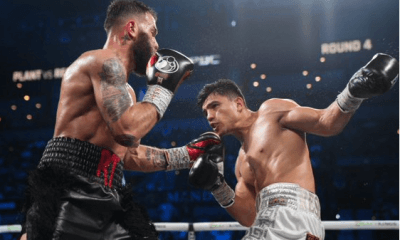
 Featured Articles4 weeks ago
Featured Articles4 weeks agoA Night of Mismatches Turns Topsy-Turvy at Mandalay Bay; Resendiz Shocks Plant
-

 Featured Articles2 weeks ago
Featured Articles2 weeks agoAvila Perspective, Chap. 330: Matchroom in New York plus the Latest on Canelo-Crawford
-

 Featured Articles1 week ago
Featured Articles1 week agoVito Mielnicki Jr Whitewashes Kamil Gardzielik Before the Home Folks in Newark
-
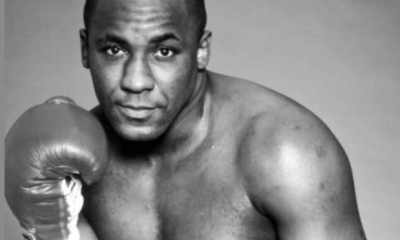
 Featured Articles4 weeks ago
Featured Articles4 weeks agoRemembering the Under-Appreciated “Body Snatcher” Mike McCallum, a Consummate Pro
-

 Featured Articles4 weeks ago
Featured Articles4 weeks agoAvila Perspective, Chap 329: Pacquiao is Back, Fabio in England and More
-

 Featured Articles3 weeks ago
Featured Articles3 weeks agoOpetaia and Nakatani Crush Overmatched Foes, Capping Off a Wild Boxing Weekend
-

 Featured Articles3 weeks ago
Featured Articles3 weeks agoFabio Wardley Comes from Behind to KO Justis Huni
-

 Featured Articles2 weeks ago
Featured Articles2 weeks agoCatching Up with Clay Moyle Who Talks About His Massive Collection of Boxing Books



